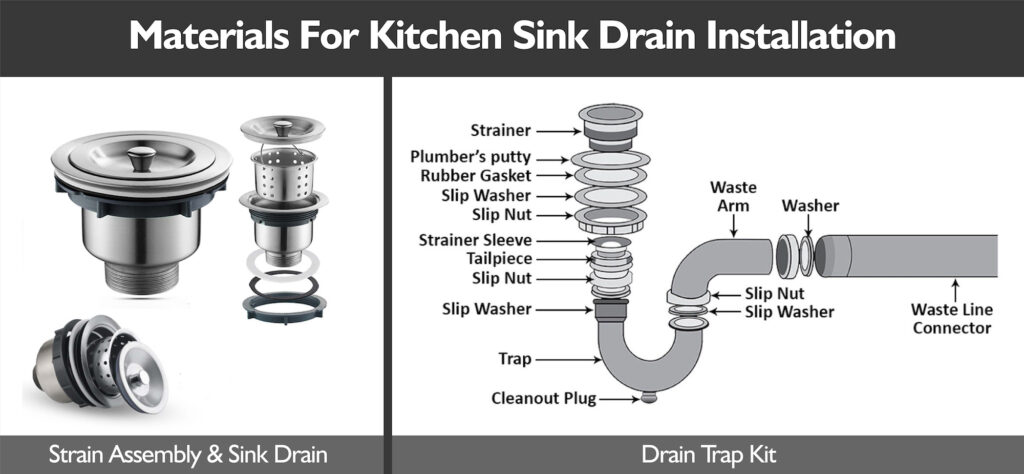Dealing with a clogged or leaking kitchen sink drain can be frustrating․ However, with the right tools and a little know-how, many common plumbing issues can be resolved without calling a professional․ This guide provides a comprehensive overview of DIY kitchen sink drain plumbing, covering everything from identifying common problems to step-by-step instructions for repairs and replacements․ By following these instructions, you can save money and gain valuable plumbing skills․
Understanding Your Kitchen Sink Drain System
Before diving into repairs, it’s important to understand the components of your kitchen sink drain system․ Knowing the names and functions of each part will make diagnosing and fixing problems much easier․
- Sink Strainer: Catches food particles and debris to prevent clogging․
- Tailpiece: The vertical pipe that connects the sink strainer to the P-trap․
- P-trap: A U-shaped pipe that holds water to prevent sewer gases from entering your home․
- Drain Arm: The horizontal pipe that connects the P-trap to the drainpipe in the wall․
- Drainpipe: The pipe in the wall that carries wastewater away․
Common Kitchen Sink Drain Problems
Several issues can arise with your kitchen sink drain․ Identifying the problem is the first step towards fixing it․
- Clogs: The most common issue, often caused by food scraps, grease, and hair․
- Leaks: Can occur at any connection point, often due to loose fittings or damaged pipes․
- Slow Draining: Indicates a partial clog or a problem with the vent pipe․
- Sewer Gas Odor: Usually caused by a dry P-trap or a problem with the vent pipe․
Tools and Materials You’ll Need
Having the right tools and materials on hand will make the job much easier․ Here’s a list of essentials:
- Basin Wrench: For loosening and tightening hard-to-reach nuts․
- Pipe Wrench: For gripping and turning pipes․
- Plunger: For clearing minor clogs․
- Plumber’s Tape: For sealing threaded connections․
- Channel-Lock Pliers: For gripping and turning nuts and bolts․
- Bucket: To catch water and debris․
- Screwdrivers (Phillips and Flathead): For various tasks․
- New Drain Parts (if replacing): Tailpiece, P-trap, drain arm, etc․
Step-by-Step Guide to Clearing a Clogged Kitchen Sink Drain
A clogged drain is a common problem, and often easily resolved․ Follow these steps:
- Try a Plunger: Fill the sink with enough water to cover the cup of the plunger․ Position the plunger over the drain and push and pull vigorously for several minutes․
- Use a Drain Snake: Insert the drain snake into the drain opening and rotate it to break up the clog․ Pull out the snake and remove any debris․ Repeat as needed․
- Check the P-Trap: Place a bucket under the P-trap․ Loosen the slip nuts on either side of the P-trap and remove it․ Clean out any debris inside the P-trap․
Replacing a Kitchen Sink Drain
If your drain is damaged or corroded, you may need to replace it․ Here’s how:
- Turn Off the Water Supply: Locate the shut-off valves under the sink and turn them off․
- Disconnect the Old Drain: Loosen the slip nuts connecting the tailpiece, P-trap, and drain arm․ Remove the old drain parts․
- Install the New Drain: Assemble the new drain parts, using plumber’s tape on threaded connections․ Tighten all slip nuts securely․
- Test for Leaks: Turn on the water supply and check for leaks․ Tighten any connections that are leaking․
Preventing Future Drain Problems
Prevention is key to avoiding future drain problems․ Here are some tips:
- Avoid Pouring Grease Down the Drain: Grease solidifies and clogs pipes․
- Use a Sink Strainer: To catch food particles and debris․
- Flush the Drain Regularly: Pour boiling water down the drain once a week to flush out grease and debris․
- Avoid Disposing of Coffee Grounds Down the Drain: They can accumulate and cause clogs․
FAQ: Kitchen Sink Drain Plumbing
Q: How often should I clean my P-trap?
A: Cleaning your P-trap every 6-12 months can help prevent clogs and maintain good drainage․
Q: What should I do if my drain is still clogged after trying these methods?
A: If you’ve tried these methods and your drain is still clogged, it’s best to call a professional plumber․
Q: Can I use chemical drain cleaners?
A: While chemical drain cleaners can be effective, they can also damage your pipes and pose a health hazard․ It’s generally best to avoid them․
Q: How do I know if I need to replace my kitchen sink drain?
A: If your drain is corroded, leaking, or constantly clogging, it may be time to replace it․
Factoid: Did you know that the P-trap was invented in the 1880s and is designed to trap debris and prevent sewer gases from entering your home?
Q: What is plumber’s tape used for?
A: Plumber’s tape, also known as Teflon tape, is used to create a watertight seal on threaded pipe connections․
Factoid: A common cause of slow draining in kitchen sinks is the buildup of soap scum and mineral deposits in the pipes․ Regular flushing with hot water can help prevent this․
Q: What is the best way to dispose of cooking oil?
A: The best way to dispose of cooking oil is to let it cool, then pour it into a sealed container and dispose of it in the trash․ Never pour it down the drain․
Q: How do I prevent fruit flies from breeding in my kitchen sink drain?
A: Regularly clean your drain with a mixture of baking soda and vinegar, followed by boiling water․ This will help kill any fruit fly larvae․
By following this guide, you can confidently tackle many common kitchen sink drain plumbing issues․ Remember to always prioritize safety and consult a professional if you’re unsure about any step․ With a little effort, you can keep your kitchen sink drain running smoothly and save money on costly plumbing repairs․

